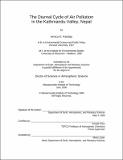| dc.contributor.advisor | Ronald Prinn. | en_US |
| dc.contributor.author | Panday, Arnico Kumar | en_US |
| dc.contributor.other | Massachusetts Institute of Technology. Dept. of Earth, Atmospheric, and Planetary Sciences. | en_US |
| dc.coverage.spatial | a-np--- | en_US |
| dc.date.accessioned | 2007-05-16T16:11:49Z | |
| dc.date.available | 2007-05-16T16:11:49Z | |
| dc.date.copyright | 2006 | en_US |
| dc.date.issued | 2006 | en_US |
| dc.identifier.uri | http://hdl.handle.net/1721.1/37361 | |
| dc.description | Thesis (Sc. D.)--Massachusetts Institute of Technology, Dept. of Earth, Atmospheric, and Planetary Sciences, 2006. | en_US |
| dc.description | This electronic version was submitted by the student author. The certified thesis is available in the Institute Archives and Special Collections. | en_US |
| dc.description | Includes bibliographical references (p. 213-230). | en_US |
| dc.description.abstract | This dissertation describes the most comprehensive study to date of the diurnal cycle of air pollution in the Kathmandu Valley, Nepal -- a bowl-shaped mountain valley of two million people with a growing air pollution problem but little past research. Field measurements and computer simulations were used to study the interplay of emissions and ventilation. From September 2004 through June 2005, CO (carbon monoxide), ozone, PM10 (particles smaller than 10 micrometers), wind speed and direction, solar radiation, temperature, and humidity were continuously measured east of Kathmandu. Sensors towers and mountains measured the diurnal cycle of the vertical temperature structure and stability. A sodar measured the mixed layer height and upper-level winds. Bag sampling provided the diurnal cycle of CO on mountains, passes and around the valley. Winds were measured on a mountain pass and ozone on a mountaintop. Patterns of air pollution and meteorology in the valley showed remarkable day-to-day similarity, with daily twin peaks of CO and PM10, a noon ozone maximum, afternoon westerly winds, and a stagnant cold pool at night. On mountaintops at night, ozone remained high, while CO dropped to regional background levels. | en_US |
| dc.description.abstract | (cont.) The meso-scale meteorological model MM5 was adapted to the Kathmandu Valley for days in February and May 2005. It was able to capture the essential features of the valley's meteorology and was used to address three specific questions: The break-up of the valley's temperature inversion was found to be dominated in February by up-slope winds on the valley rim, plus subsidence over the valley center; in May surface heating of the valley bottom also played a major role. The pathways of pollutant transport out of the valley were found to be up the valley rim slopes in the morning, but out the eastern and southern passes in the afternoons. At night pollutants remained within the valley except near the river outlet. They were lifted off the ground at night and re-circulated in the morning. The eulerian chemistry transport model CAMx, was used in tracer mode, with MM5 meteorology to simulate the emission, transport and removal of CO from the Kathmandu Valley. The simulations were limited by the accuracy of Kathmandu's emissions inventory, especially the spatial distribution of emissions. | en_US |
| dc.description.statementofresponsibility | by Arnico K. Panday. | en_US |
| dc.format.extent | 230 p. | en_US |
| dc.language.iso | eng | en_US |
| dc.publisher | Massachusetts Institute of Technology | en_US |
| dc.rights | M.I.T. theses are protected by copyright. They may be viewed from this source for any purpose, but reproduction or distribution in any format is prohibited without written permission. See provided URL for inquiries about permission. | en_US |
| dc.rights.uri | http://dspace.mit.edu/handle/1721.1/7582 | |
| dc.subject | Earth, Atmospheric, and Planetary Sciences. | en_US |
| dc.title | The diurnal cycle of air pollution in the Kathmandu Valley, Nepal | en_US |
| dc.type | Thesis | en_US |
| dc.description.degree | Sc.D. | en_US |
| dc.contributor.department | Massachusetts Institute of Technology. Department of Earth, Atmospheric, and Planetary Sciences | |
| dc.identifier.oclc | 86125754 | en_US |
